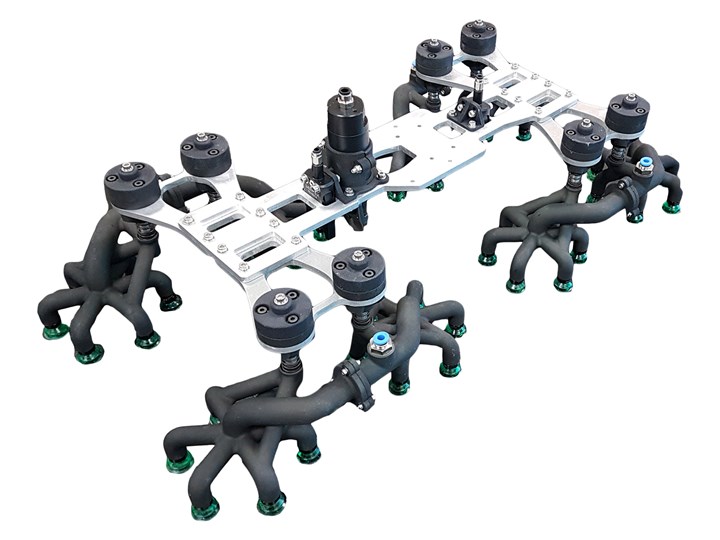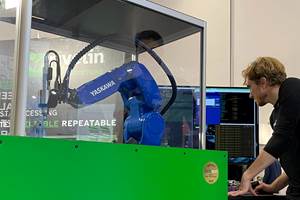Founded in 2014, Anubis 3D (Mississauga, Ontario, Canada) is a polymer AM service provider of end-of-arm-tooling (EOAT) and on-demand industrial components for prototype and low-volume production operations. The company describes itself as positioned between automation systems integrators/robot suppliers and end users/manufacturers. As such, it supports customers in multiple industries globally — including automotive, consumer, packaging, electronics, medical/dental, aerospace and plastics molding.
Anubis 3D focuses on polymer AM solutions for robots and especially cobots, including surface grippers, pick-and-place EOAT, automatic carton erectors, external bottle grippers, jigs and fixtures, and integrated vacuum toolchangers, as well as manual toolchangers and custom tools. These lightweight solutions are said to reduce fatigue and wear on the robot, enable smaller robots to be used to accomplish the same task or allow a given robot to move faster owing to the lower inertia of moving a lighter tool.
Most of the EOAT that Anubis 3D designs for molders are either large tools that grab big moldings like bumper fascia (top, right half of tool shown with blue suction grippers and black pinchers) or intricate spider tools that extract multiple small parts like pizza-saver discs from multicavity tools, clip sprues/runners and sort parts into bins (bottom). Molders typically provide fixing points that comply with the surface of parts being extracted from molds and ask Anubis to develop a tool that can interface with a robot designed to perform that action. Photo Credit: Anubis 3D Industrial Solutions Inc.
“The market took us to end-of-arm tools and collaborative robots where lightweight tools are needed so humans working alongside cobots aren’t injured,” Tharwat Fouad, Anubis 3D CEO, explains. “Since a tool isn’t sensitive and could hurt someone, it’s important to ensure the EOAT have smooth surfaces, there are no pinch points and no exposed actuators or sharp corners and nothing that could grab someone’s finger and break it. It’s hard to comply with that using a metal tool, so it’s kind of a default for cobot EOAT suppliers to use plastic-bodied devices not only for weight — since cobots are payload constrained — but also for safety.”
“We got into this segment by accident,” Mona Louca, Anubis marketing director adds. “Our previous company designed manufacturing lines and we couldn’t find the components we needed so we started developing them on our own.”
She explains that the team tended to work on projects that were hard to execute — in old plants with no space and tight corners where it was a real challenge to squeeze in a new line or upgrade an existing one.
“We started researching what we could do on our own and discovered additive manufacturing,” Louca continues. “As we educated ourselves and outsourced production of early components, we saw the viability of the technology, which enabled us to produce the kinds of smart solutions our customers needed.”
As the company brought printing capabilities in-house, and interest grew, it eventually spun off the Anubis 3D division, which has since eclipsed the original company. “One thing we’ve learned is that it’s important to be on the other side in order to understand your customer’s pain points so you can provide viable solutions,” Louca notes.
The company uses two different polymer additive technologies. It uses iSLA 1900D model SLA printers from ZRapid Tech (Suzhou, China) to prototype the surface geometry of parts that will be handled owing to the process’ high surface quality, which facilitates developing EOAT and fixtures that are correctly designed to interface with actual part surfaces. For production applications, the company uses P100, P110 and P385 model SLS printers from EOS, primarily printing PA12, which is often overcoated with cold-pour/room temperature-cure polyurethane (PUR) to create soft-grip/soft-touch surfaces to interface with sensitive parts.
“We’re an engineering company that designs robust products using the scientific method to determine features, thicknesses, acceptable deflections, impact loads and the like,” Fouad continues. “We conduct rigorous FEA analyses when designing these tools where we consider the kinds of forces they’ll be subject to, the kinds of safety factors we need and possible mishaps that could happen. If a robot goes out of whack and breaks a component, and your EOAT is metal, then in most cases it will bend and yield and not be repairable, so a customer will need to order a full replacement. However, because polymers are better at absorbing impact energies and we design modular assemblies, then chances are that even if a tool falls on the floor, it won’t break, and if it does break, then only a small piece or two will need to be replaced.”
“We don’t believe in taking a one-size-fits-all approach as we know additive isn’t the solution for everything,” Louca adds. “However, for complex tools and small part sizes, it wins out nearly every time. It’s a nice type of business because we don’t have to be involved with the entire process, so that really streamlines projects.”
More From This Author
Peggy Malnati is a Detroit-based contributing writer for CompositesWorld magazine, for which she primarily reports on automotive and ground transportation. SUBSCRIBE HERE
Related Content
The Robot Craftsman: Force Sensing and Vision Help Realize Automated AM Postprocessing (Includes Video)
Automated production via additive manufacturing will need automated postprocessing. This UK startup is equipping robots with the capabilities needed for critical, fine-detail finishing of metal 3D printed parts.
Read MoreHow Avid Product Development Creates Efficiencies in High-Mix, Low-Volume Additive Manufacturing
Contract manufacturer Avid Product Development (a Lubrizol company) has developed strategies to streamline part production through 3D printing so its engineering team can focus on development, design, assembly and other services.
Read MoreCopper, New Metal Printing Processes, Upgrades Based on Software and More from Formnext 2023: AM Radio #46
Formnext 2023 showed that additive manufacturing may be maturing, but it is certainly not stagnant. In this episode, we dive into observations around technology enhancements, new processes and materials, robots, sustainability and more trends from the show.
Read MoreVideo: Construction 3D Printing with Robotics, Geopolymer
Alquist 3D is aiming to revolutionize construction and infrastructure with large-format robotic 3D printing using a carbon-neutral material.
Read MoreRead Next
Savage Automation Delivers 3D Printed Commercial Manufacturing Aids
The company's approach to designing end-of-arm tooling and other devices has evolved over the years to support longevity and repairs.
Read More3D Printed Human-Operated End-of-Arm Tooling Promotes Safety and Throughput
Toolmaker and injection molder Zero Tolerance developed a manual tool to enable an operator to quickly place inserts into a mold.
Read MoreLaser-Sintered Grippers Solve Robotic Packing Challenges
Additive manufacturing produced lighter, stronger vacuum grippers for robots on a food packaging line.
Read More

.jpg;width=70;height=70;mode=crop)






















